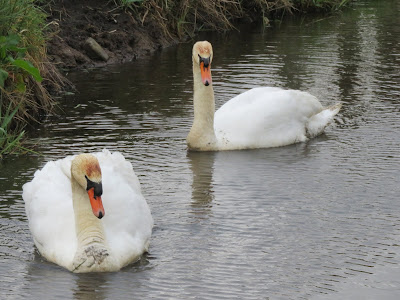Mute swan (Cygnus olor)

Common name: Mute swan Species name: Cygnus olor Bird type: waterfowl Origin : Temperate Europe to Western Asia When to see: all year round Description: Adults are large white birds with a long neck, an orange bill with a black base and nob, and black feet. They are territorial during the breeding season but more gregarious during the winter. The cygnets are fluffy and grey, and the juveniles are less fluffy and grey, with patches of white as the adult feathers come through. Their bills are black, only turning orange in adulthood. Mute swans on the North Drove Mute swan juveniles with some adult feathers showing Location: Common. In summer there is often a pair on the North Drove and at least one other on 10-foot. During the winter they congregate in the fields around the End Drove. They also like to gather in field 115 when it's flooded.




